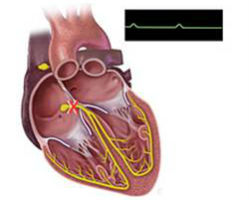Causes of AV Nodal Blocks
First degree AV block
 The most common causes for first degree AV block include:
The most common causes for first degree AV block include:
- Enhanced vagal tone – the hyperactivity of vagus nerve can be often seen in professional athletes with their heart rate reaching 60 beats per minute while resting.
- Myocarditis – inflammation of the heart’s muscle can lead to the damage of the atrioventricular node resulting in AV block
- Acute myocardial infarction – particularly of the inferior wall of the heart is affected, can lead to damage of AV node.
- Drugs – Class Ia antiarrhythmics (e.g. quinidine), Class Ic antiarrhythmics (e.g. flecainide), Class II antiarrhythmics (beta-blockers), Class III antiarrhythmics (e.g. amiodarone), Class IV antiarrhythmics (calcium channel blockers), cardiac glycosides, and magnesium can all lead to an AV block. Although first degree AV block is not an absolute contraindication for using drugs mentioned above, extreme caution should still be used as the continuation of use of these drugs can lead to a higher-degree AV block.
- Aortic or mitral valve annulus calcification can lead to the Infra-Hisian AV block, since the bundle of His is located near those valves.
- Infectious diseases – Diphtheria, infective endocarditis, Chagas disease, rheumatic fever, tuberculosis, Lyme disease, can all result in first-degree AV block. Acute myocarditis caused by these infections poses an even greater risk of causing an AV block.
- Collagen vascular disease – scleroderma, systemic lupus erythematosus, and rheumatoid arthritis can all be the cause of first-degree AV block.
Second and third degree AV block
Second and third degree AV block can be the result of:
- Inflammatory diseases including myocarditis, endocarditis, Lyme disease, and acute rheumatic fever.
- Infiltrative diseases such as hemochromatosis, amyloidosis, and sarcoidosis (AV block is usually the first sign of this disease)
- Infiltrative malignancies including multiple myeloma and Hodgkin lymphoma.
- Endocrine and metabolic disorders such as hypermagnesemia, hyperkalemia, hyperthyroidism, Addison disease, thyrotoxic periodic paralysis, and myxedema.
- Collagen vascular diseases – lupus erythematosus, Reiter syndrome, scleroderma, rheumatoid arthritis, dermatomyositis, and ankylosing spondylitis.
Other risk factors include:
- Cardiac tumors
- Trauma, including damage done by catheter, especially if the left bundle-branch block already existed
- Myocardial bridging – a condition during which a coronary artery tunnels through the tissues of the heart rather than resting on top of it.
- Transcatheter closure of ventricular and atrial septal defects.
- Heart surgery, especially near the septum.
- Age-related fibrosis of the myocardium.
- Complications of valvular heart disease including aortic stenosis and replacement surgery of the aortic valve.
- Muscular dystrophies
- Acute ethanol poisoning
- Inferior and anterior wall myocardial infarction. Myocardial infarction of the anterior wall is generally associated with damage to the bundle of His, while inferior wall myocardial infarction can cause atrioventricular block.
Next Chapter: Symptoms of AV nodal blocks
Featured Articles
A stroke can cause problems with communication if there is damage to the parts of the brain responsi ...
People with irregular bowel movements often complain about elevated blood pressure that doesn’ ...
A mini-stroke is a temporary disruption in blood flow to the brain, spinal cord or retina that doesn ...
It is well known that rheumatoid arthritis is an auto-immune disease that primarily affects joints. ...









